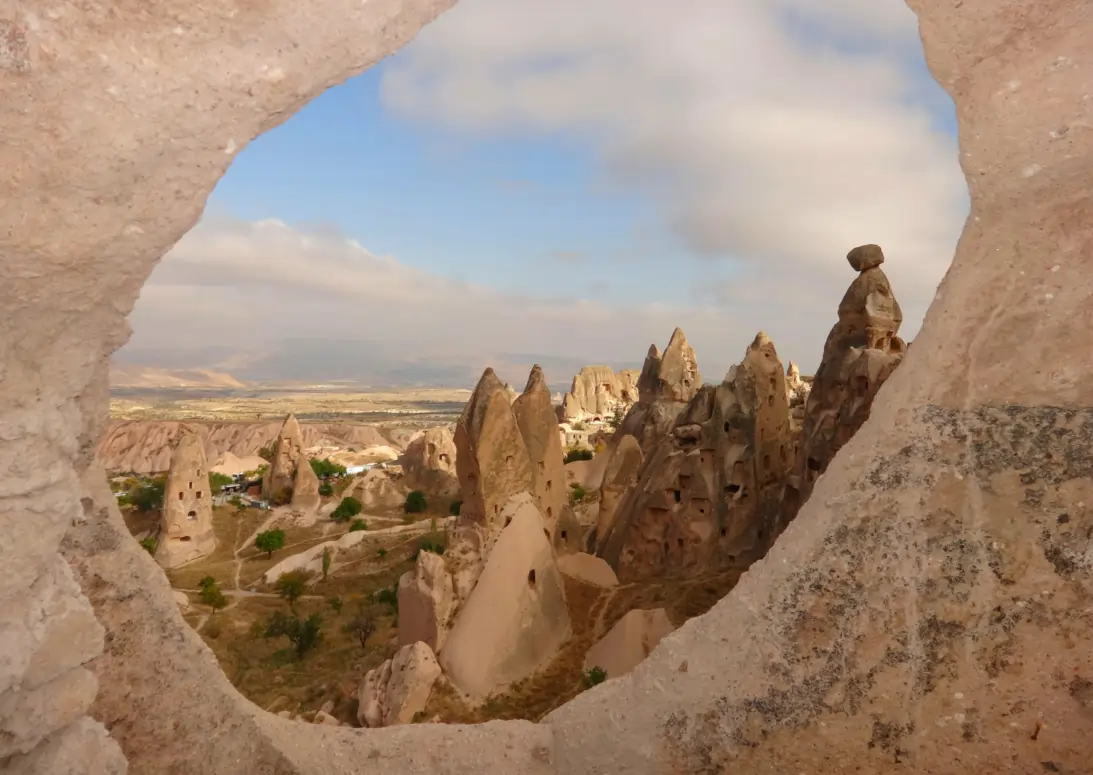The Fairy Chimneys of Cappadocia: Nature's Masterpieces
Your ultimate guide to the natural wonders in Cappadocia, Turkey.
Nestled in the heart of central Turkey, the Fairy Chimneys of Cappadocia rise like ethereal sentinels, casting a spell on all who lay eyes upon them. These extraordinary geological formations, resembling ancient towering sculptures, stand as a testament to the awe-inspiring power of nature. Picture a landscape straight out of a fairytale, where whimsical rock formations, shaped by centuries of wind and water erosion, create a surreal and enchanting panorama.
Imagine towering spires, mushroom-like formations, and honeycombed cliffs, all bathed in the warm glow of the rising sun. The Fairy Chimneys of Cappadocia beckon adventurers and dreamers alike, inviting them to step into a world where reality and imagination intertwine.
The Fairy Chimneys of Cappadocia are a Unique Geological Wonder

The Fairy Chimneys of Cappadocia stand as a testament to the harmonious coexistence of nature, history, and culture. These otherworldly formations not only captivate with their ethereal beauty but also hold immense geological importance.
The intricate process of their formation, spanning millions of years, is a testament to the Earth’s remarkable ability to shape and reshape itself. Moreover, the Fairy Chimneys have played a significant role in the lives of the people of Cappadocia throughout history. From providing shelter to ancient civilizations to serving as monastic retreats for early Christians, these rock formations have witnessed the ebb and flow of human existence.
Formation of Fairy Chimneys
Cappadocia’s breathtaking landscape, adorned with its enchanting fairy chimneys, owes its existence to a series of awe-inspiring volcanic eruptions that unfolded millions of years ago. These cataclysmic events, fuelled by the Earth’s fiery core, unleashed a torrent of molten lava and ash, which ultimately laid the foundation for the unique geological wonders we witness today.
During these ancient eruptions, molten lava flowed across the land, leaving behind layers upon layers of hardened rock. Over time, as the lava cooled and solidified, it formed a type of rock known as tuff. This soft and easily erodible material became the building blocks for the fairy chimneys that grace the Cappadocian landscape.
Nature’s artistic hand, in the form of wind and water erosion, then took centre stage, shaping and sculpting the soft tuff into the distinctive chimney-like formations we now call fairy chimneys. The relentless forces of wind and water worked in harmony, chiselling away at the tuff, gradually revealing the hidden beauty within.
The wind, with its persistent gusts, carried abrasive particles that acted as natural sculpting tools, delicately etching intricate patterns into the tuff. Over time, these patterns evolved into the characteristic cones, pillars, and mushrooms that define the fairy chimneys of Cappadocia.
Water, too, played a vital role in the formation of these geological wonders. Rainfall, combined with occasional flash floods, eroded the tuff, gradually wearing it down and exposing the underlying layers. The gentle touch of water, flowing through the intricate network of cracks and crevices, further shaped the fairy chimneys, adding a touch of elegance to their already captivating forms.

Cappadocia's Rich History as a Crossroads of Civilisations
The story of Cappadocia begins with the Hittites, an ancient Anatolian civilization that thrived in the 2nd millennium BCE. Their presence in the region laid the foundation for subsequent civilizations to flourish. However, it was during the Persian rule in the 6th century BCE that Cappadocia truly emerged as a cultural and political hub. The Persians recognized the region’s strategic importance and established it as a satrapy, or province, within their vast empire.
From the Romans to the Ottoman Empire
The Romans, known for their insatiable appetite for conquest, eventually annexed Cappadocia in the 1st century BCE. Under Roman rule, the region experienced a period of prosperity and development. The Romans recognized the unique geological formations of Cappadocia, particularly the fairy chimneys, and utilized them for various purposes, including as burial sites and dwellings.
The Byzantine Empire, following the decline of the Roman Empire, played a significant role in shaping the cultural and architectural heritage of Cappadocia. During the Byzantine era, which spanned from the 4th to the 15th century CE, the region became a refuge for early Christians fleeing persecution. The Byzantines carved intricate rock-cut churches and monasteries into the soft volcanic rock, creating a unique and awe-inspiring underground network of religious sanctuaries. These remarkable structures, adorned with vibrant frescoes, stand as a testament to the devotion and artistic prowess of the Byzantine civilization.
The Ottoman Empire, known for its vast territorial expansion, conquered Cappadocia in the 15th century. The Ottomans, recognizing the region’s strategic significance, further developed its architectural landscape. They constructed mosques, caravanserais, and other public buildings, blending their own architectural style with the existing Byzantine influence. This fusion of cultures left an indelible mark on the region, adding yet another layer to its historical significance.
Place of Shelter and Religion
Early inhabitants ingeniously carved out multiple levels within the fairy chimneys, creating multi-story dwellings complete with ventilation shafts and even rudimentary plumbing systems. In addition to serving as homes, the fairy chimneys also became sacred spaces for religious worship. The early Christians who sought refuge in Cappadocia during the Byzantine era utilized these natural formations to establish hidden churches and monastic complexes. These rock-cut churches, adorned with breathtaking frescoes depicting biblical scenes, served as havens for worship and spiritual contemplation. The intricate carvings and vibrant colors of the frescoes are a testament to the artistic skill and devotion of the early Christian communities.
Cultural Heritage Surrounding The Fairy Chimneys
The villages surrounding the Fairy Chimneys in Cappadocia are not only home to breathtaking natural wonders but also to a rich tapestry of cultural traditions and practices that have been passed down through generations. These customs, crafts, and culinary traditions provide a glimpse into the vibrant heritage of the local communities.
The customs observed in these villages are deeply rooted in their historical and geographical context. One such tradition is the art of pottery making, which has been practiced for centuries. Skilled artisans mold clay into exquisite vessels, drawing inspiration from the distinctive shapes and colors of the Fairy Chimneys themselves. This craft not only serves as a means of artistic expression but also as a source of income for many local families.
In addition to pottery, the villages surrounding the Fairy Chimneys boast a rich culinary heritage. Traditional recipes, handed down from mothers to daughters, showcase the flavors and ingredients unique to the region. From hearty stews made with locally sourced vegetables to delicate pastries filled with sweet apricots, each dish tells a story of the land and its people. Visitors have the opportunity to immerse themselves in the culinary traditions by participating in cooking workshops or savoring the local delicacies at traditional restaurants.

The Fairy Chimneys in Folklore, Mythology, and Local Legends
The Fairy Chimneys hold a special place in the folklore, mythology, and local legends of Cappadocia. These towering rock formations, with their whimsical shapes and ethereal presence, have captivated the imaginations of both locals and visitors alike.
According to local legends, the Fairy Chimneys were once believed to be inhabited by fairies and other supernatural beings. It was said that these mystical creatures would emerge from the chimneys at night, bringing good fortune and granting wishes to those who encountered them. This belief has been passed down through generations, becoming an integral part of the cultural fabric of the region.
In addition to their association with fairies, the Fairy Chimneys also feature prominently in various myths and legends. One such tale tells the story of a brave warrior who sought refuge in the caves carved into the chimneys during a great battle. It is said that he emerged victorious, thanks to the protective powers of the Fairy Chimneys. These stories not only entertain but also serve as a reminder of the deep connection between the land and its people.

Visiting The Captivating Fairy Chimneys
Cappadocia, with its enchanting Fairy Chimneys, has emerged as a captivating tourist destination in recent years. The region has witnessed a significant surge in the number of visitors, and it is not difficult to understand why. The unique geological formations, rich history, and cultural heritage of Cappadocia have all contributed to its growing popularity.
One of the primary reasons behind the attraction of Cappadocia is the Fairy Chimneys themselves. These extraordinary rock formations, shaped by centuries of natural erosion, resemble whimsical chimneys or even otherworldly beings. Their surreal appearance has captured the imagination of travelers from around the globe, drawing them to this remarkable destination.
Furthermore, Cappadocia offers a plethora of activities and attractions that cater to a wide range of interests. From exhilarating hot air balloon rides that provide panoramic views of the Fairy Chimneys and the surrounding landscapes, to awe-inspiring hiking and trekking trails that allow visitors to immerse themselves in the region’s natural beauty, there is something for everyone in Cappadocia.
Activities on Offer in Cappadocia
- Hot air balloon rides: Hot air ballooning in Cappadocia is breathtaking, and offers a truly unforgettable experience. As the sun rises over the Fairy Chimneys, visitors are treated to a mesmerizing spectacle as the colorful balloons float serenely above the unique landscape. This activity allows tourists to appreciate the sheer magnificence of Cappadocia from a different perspective, creating memories that will last a lifetime.
- Hiking and trekking trails: For those seeking a more active adventure, Cappadocia boasts an extensive network of hiking and trekking trails. These trails wind through the picturesque valleys, allowing visitors to discover hidden caves, ancient churches, and panoramic viewpoints. Whether it’s a leisurely stroll or a challenging hike, Cappadocia’s trails cater to all levels of fitness and provide an opportunity to immerse oneself in the region’s natural wonders.
- Exploring underground cities: Cappadocia is home to a fascinating network of underground cities, carved out of the soft volcanic rock by ancient civilizations. These subterranean labyrinths, such as Derinkuyu and Kaymakli, offer a glimpse into the ingenuity and resilience of the people who once inhabited them. Visitors can explore the intricate tunnels, secret chambers, and ventilation shafts, marveling at the architectural marvels that lie beneath the surface.
- Göreme Open Air Museum: A visit to the Göreme Open Air Museum is a must for any traveler to Cappadocia. This UNESCO World Heritage site showcases a collection of rock-cut churches, adorned with exquisite frescoes dating back to the Byzantine era. The museum provides a fascinating insight into the region’s rich cultural and religious history, allowing visitors to appreciate the artistic and architectural achievements of the past.
Final Thoughts
The Fairy Chimneys of Cappadocia stand as a testament to the extraordinary forces of nature and the rich history and culture that have shaped this region. Throughout this article, we have delved into the fascinating details of these rock formations, uncovering their geological origins, historical significance, and cultural allure.
The Fairy Chimneys, with their whimsical shapes and surreal landscapes, are the result of millions of years of volcanic activity and erosion. Composed of volcanic ash and basalt, these towering formations have been sculpted by wind and water into their unique shapes, resembling chimneys, mushrooms, and even castles. This geological marvel is a true wonder of the natural world.
Beyond their geological significance, the Fairy Chimneys hold deep historical and cultural importance. Recognizing the natural protection provided by these formations, the ancient inhabitants of Cappadocia carved out homes, churches, and entire underground cities within the soft volcanic rock. These underground cities served as shelters during times of invasion and persecution, offering a glimpse into the resilience and resourcefulness of the people who once thrived in this region.
The enduring allure of the Fairy Chimneys lies in their timeless beauty and the indescribable sense of wonder they evoke. These rock formations, standing tall against the backdrop of the Cappadocian landscape, have the power to captivate and inspire visitors from around the world.
